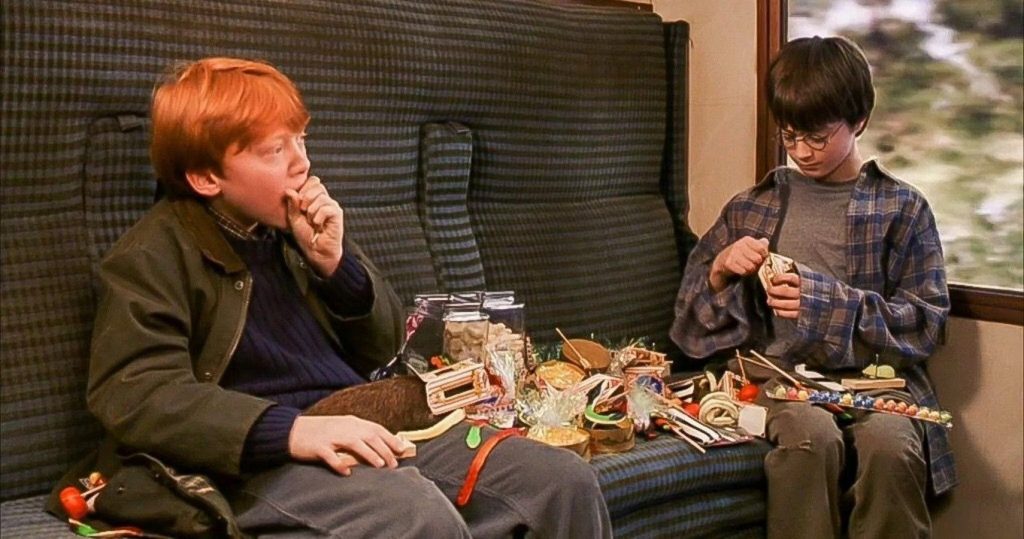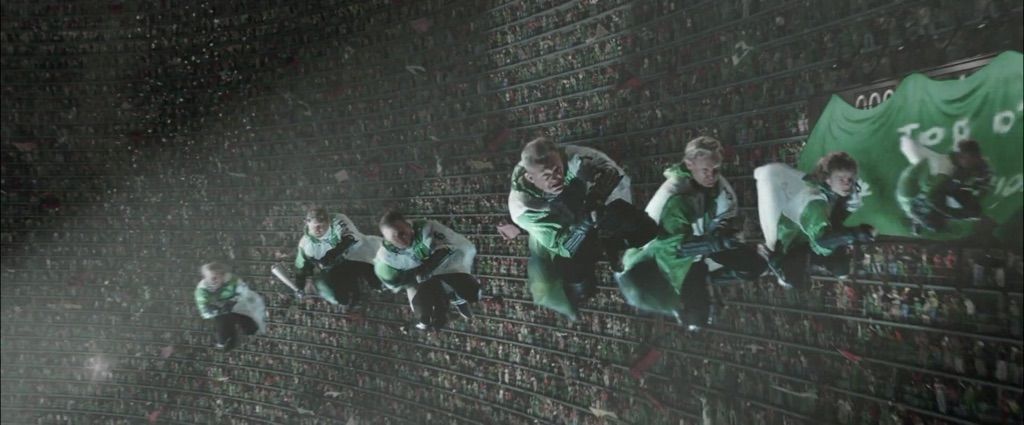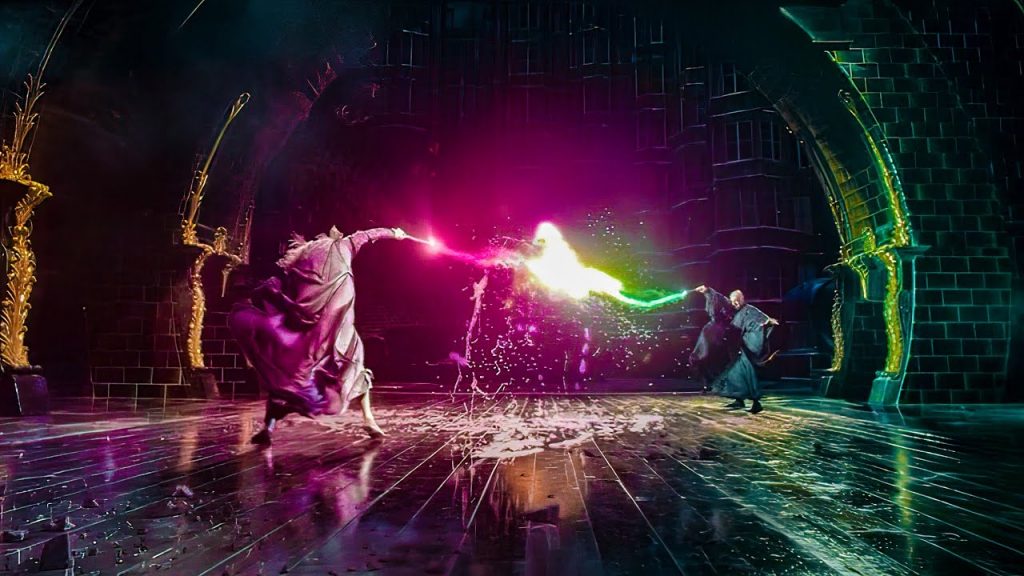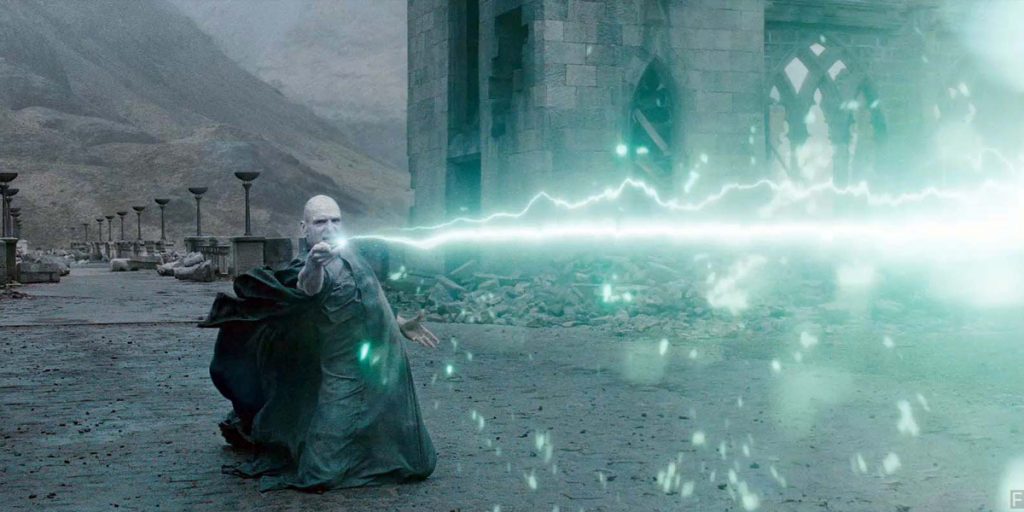The success of the Harry Potter franchise cannot be understated, but its movies fall short in bringing the biggest strength of the wizarding world to life: the worldbuilding.
There is a scene in the first Harry Potter book, “Harry Potter and the Philosopher’s Stone,” where main character, Harry, is on a train, and buys a bucketload of magical sweets. They range from simpler ones like pasties or cakes to jelly beans with flavors such as eggs or earwax, to chocolate frogs that come with magical trading cards. Nothing really happens in that scene. Harry doesn’t learn some new secret about his destiny, nor does any villain introduce themselves. It is just worldbuilding, with him eating each sweet and finding more about it. This remains my favorite scene in the entire franchise.
Written by J.K.Rowling, the Harry Potter series outlines the story of the titular character finding out that he is a wizard and going to a magical school called Hogwarts, and then learning he is wrapped up in a deadly struggle spanning seven books, with wands, prophecies, and a noseless dark wizard. It is easily one of the most famous pop culture franchises, right up there with Star Wars or Lord of the Rings, and it has broken every 11 year old’s hearts when they discovered they wouldn’t be getting a letter to Hogwarts.
With such a beloved series, film adaptations were inevitable, hence eight movies released from 2001 to 2011 that cover the entire saga, starring Daniel Radcliffe, Rupert Grint, and Emma Watson. While the films are not without their ups and downs, they are still generally touted as well made and a faithful adaptation. In some cases, the movies are often seen as the definitive version of Rowling’s wizarding world, to the point where any movie starring Daniel Radcliffe would inevitably bring Harry Potter memes along.
However, that is where I have to disagree. Now, I have had my fair share of enjoyment with the series in the past. Every once in a while, I go to my bookshelf, take out a book and look up three hours later with a severe cramp in my neck from bending down to the pages. Yet the same cannot be said for the films, as almost all of them have a crucial element missing, an element that I saw as the greatest strength of the books: worldbuilding.
HOW THE HARRY POTTER BOOKS CRAFT A METICULOUS WORLD

Nowadays, when it comes to magic schools or wizard outfits or magic wands, the image most people think about comes from Harry Potter, all because Rowling was so meticulous in her worldbuilding, laying out different details of the universe down to a fine line. From the moving pictures in newspapers to themed spellbooks that must make maintaining magical bookstores a living hell to magical sports that have been overanalyzed far too much, so many minute things about the wizarding world are explained, from magical appliances to government systems.
The sweets scene I outlined in the beginning is a perfect example. You’re just finding out little details about this world, small things most people wouldn’t give much thought about. Yet, these details make this magical world even more believable. After all, it’s unlikely wizards would have the same culture as we do, even down to snacks. Scenes like this are littered even up to the final book, fully sketching out what this world is like. Admittedly, when you hear about soul sucking deep kissers, giant attacks, and the occasional rise of a psychotic genocidal dark wizard, you might realize living in this universe might be more trouble than it’s worth, but that still doesn’t change the fact that this world is creative, tangible, and indeed magical. I could just read an encyclopedia about the wizarding world and I’d still be entertained.
IT’S NOT ALWAYS ABOUT THE PLOT

This sort of worldbuilding is what the films fail at capturing, or to be more precise, the latter films fail at capturing. Because credit should be given where credit’s due: the first three movies, Philosopher’s Stone (2001), Chamber of Secrets (2002), and Prisoner of Azkaban (2004), do their best at bringing as much of Rowling’s vision to the screen. The magic sweets scene that I talked about before? That is also in the film and it is infinitely captivating.
Admittedly this is less the case in Chamber of Secrets, but it still shows glimmers, such as the scene where Arthur Weasley (Mark Williams), a wizard who is fascinated with the non-magical world, asks Harry, “what exactly is the function of a rubber duck?” While this is an original line that is not in the book, it still gets across what sort of character Arthur is, and also sets up how much wizards don’t know about non-magic people. In Prisoner of Azkaban, there’s a scene where Harry and his friends are in their dormitories, sharing candy that makes them behave like dogs or Thomas the Tank Engine. This is yet another original scene that had no plot relevancy, but it gives off the feeling that these people are legitimate friends, and also that this is how teens in the wizarding world goof off instead of turning on their PS5.
The important thing about these sorts of scenes is that they are focused on worldbuilding instead of plot. Of course, the plot is important, and that is what you should prioritize. However, prioritization doesn’t equal having nothing but plot. If every scene only serves to push the story forward and nothing else, it creates an incredibly dry experience that doesn’t allow for much immersion. We need those moments of downtime, dialogue, where characters just mess around with each other, drinking something called butterbeer even though they’re not of legal age, pulling a prank on bullies while invisible, or explaining the rules of a magical sport. Which is where the latter movies unfortunately start to falter.
THE FILMS FAIL AT CAPTURING THE WORLDBUILDING

To fully explain this, we need to look at the length of the books. The first three were still longer than your average bedtime story, but still relatively manageable when adapting into film. Therefore, when adapting the books, the directors could mostly follow the story scene for scene, or at the very least, trim it down without it feeling too much was left out. This is why the sweets scene I am harping way too much over could be in the movie, because the movies had enough time for worldbuilding.
Yet starting with the fourth entry, Goblet of Fire (2005), the books suddenly double, nearly triple in length from the previous three. There is a lot more plot and there are more details packed in. Now, in a book, this isn’t much of a problem. Pacing works differently with books: you can take as much time as you want, so long as you’re engaged. But with movies, you have to work with the 2-3 hour runtime limit, otherwise the audience are going to start complaining about exceptionally full bladders.
In all fairness, the movies still did a fairly good job with picking out and restructuring the most essential parts of the plot so that the 600-700 page book still works as a story in a few hours of runtime. But a film cannot function on plot alone. In the books, it still felt like life was going on in an organic, fleshed out environment. Sure, finding out that some dark wizard is brewing a plot to kill you is concerning, but that history of magic essay isn’t going to finish itself. Yet in the movies, without that worldbuilding, Hogwarts and the wizarding world feel more like backdrops for “important” events than actual places. One of the most egregious examples of this has to be during Goblet of Fire with the Quidditch World Cup. In the book, it was an exciting scene where we got to see how the wizarding world deals with sports, what sort of magical mascots the teams use such as fairies with intense aphrodisiac effect, and how much fans go crazy over their equivalent of the Super Bowl. In the movie, it feels like they’re doing something similar. They arrive at the World Cup, introduce the teams, and start the match with a massive crowd cheering. Then the scene cuts to after the match is over, and I’m left feeling like I bought and immediately dropped a sundae. Again, the decision is understandable, as putting in the actual game would have been too much a strain on the runtime and the VFX team. But it is disappointing nonetheless.
SPELLS AREN’T FUN ANYMORE

Another case where the worldbuilding of the original feels neutered is in the spells. The books had a lot of fun with their spells, where they had options ranging from turning their enemies into bats to making them tap dance to death. In addition, there were plenty of spells that weren’t used outside of combat and were just there to perform mundane tasks such as making a teacup walk on its own. And it made sense, because when you have magic, not every spell you make will be for banishing enemies or angry gnomes. Some will just be there solely to test students on their magical prowess, like high school exams about topics most people will forget about by time of graduation.
Initially, the early movies do well with this, as they accurately portray the many spells from the books. Going back to Philosopher’s Stone, during a charms class, one character aggressively corrects her partner that the pronunciation for the levitation spell is wingardium leviOOOsa, not leviosAAAA. It doesn’t have any real payoff. There is one scene later in the movie where they use it to knock out a troll by complete luck, but other than that, it has no bearing on whether Harry defeats the dark wizard. Yet having magical lessons like this makes it more believable that this is a real school, just like in the books.
However, as the movies went on, there was less time to put in jelly-leg jinxes, and so they got simpler, and therefore less interesting. For one, magical classes became more and more absent. Even up to the sixth book, “Harry Potter and the Half Blood Prince,” the characters progressed into much more difficult lessons, such as learning to casting spells without speaking them. However, in the films, starting from around Order of the Phoenix (2007), many students just start using such nonverbal spells without any real setups, removing the sense that they are following an actual curriculum.
This problem with spells persists into the action as well. Admittedly this issue with lack of variety isn’t limited to the films, but is present in the books too. With the later entries as combat situations got more dire, the characters had to be less creative and more direct with their spells, mostly coming down to stunning or killing. However, there were still some sparks of fun, such as a scene in “Harry Potter and the Deathly Hallows” where they flatten a flight of stairs for a quick getaway, then turn some curtains to stone to make pursuers collide against them.
Yet in the movie version, Deathly Hallows – Part 2 (2011), while the final battle is still exciting and bombastic with explosions bringing down parts of the castle, most of the spells come down to “bolt of light that stuns/kills.” They end up feeling not much different from Call of Duty but with wands. Of course, there are exceptions, such as the climactic duel between Dumbledore and Voldemort in Order of the Phoenix (2007). That one is a strong contender for my favorite scene in the movies, as there are multiple different spells being used, such as sending shards of glass flying at your enemy or creating a gigantic snake out of fire. But such duels are the exception rather than the norm.
A WIZARDING WORLD WITHOUT THE WORLD
All of this creates a version of the wizarding world that is still enjoyable but is far less immersive than it originally was. I don’t want to knock the directors too much. They had to work with their constraints, and, taking that context into account, they did an admirable job. Perhaps the issue lay in the format of the adaptation itself. If they had adapted the books into a series of comics, or perhaps a tv show, they would have had much more time to flesh things out. But alas, that wasn’t the case.
It’s like baking a cake, but not using any toppings. Sure, the bread and icing are sweet on their own, you’d save on some costs, and it’s not like you wouldn’t have a delicious time. But without any decorations, the cake won’t look as appetizing, and you won’t get the small pleasure of keeping that particularly big sugar topping to savor later.
Fantastic Beasts: The Secrets Of Dumbledore was released theatrically in the UK, Ireland and Japan on April 8, and in the US and worldwide on April 15, 2022. Read our article on the “Harry Potter Magic” in the Fantastic Beasts series and our ranking of all the Harry Potter Films.

